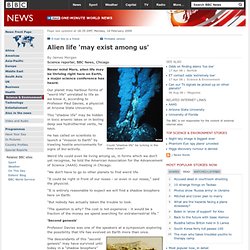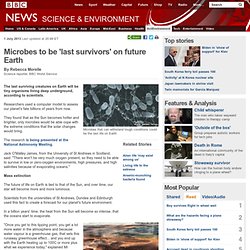

Histomap of Evolution.jpg (3212×8748) 'Digging up' 4-billion-year-old fossil protein structures to reveal how they evolved. Modern proteins exhibit an impressive degree of structural diversity, which has been well characterized, but very little is known about how and when over the course of evolution 3D protein structures arose.

In a study published by Cell Press August 8 in Structure, researchers resurrected 4-billion-year-old Precambrian proteins in the laboratory and gained novel insights into protein evolution by analyzing their X-ray crystal structures. Crossrail unearths evidence humans lived on Thames in 7,000 BC. 8 August 2013Last updated at 05:02 ET Lead archaeologist Jay Carver said the flint factory was an "exciting find" Rare evidence that humans lived on the River Thames 9,000 years ago has been discovered by archaeologists working on the Crossrail project.

A Mesolithic tool-making factory featuring 150 pieces of flint was found at the tunnelling worksite in Woolwich. Archaeologists said prehistoric Londoners were using the site to prepare river cobbles which were then made into flint tools. Gold has also been discovered at its site in Liverpool Street. Archaeologists said they were mystified as to how such a precious and expensive gold item made its way to what was then regarded as a deprived area. They believe the 16th Century gold coin was used as a sequin or pendant, similar to those worn by wealthy aristocrats and royalty.
Alien life 'may exist among us' Never mind Mars, alien life may be thriving right here on Earth, a major science conference has heard.

Our planet may harbour forms of "weird life" unrelated to life as we know it, according to Professor Paul Davies, a physicist at Arizona State University. This "shadow life" may be hidden in toxic arsenic lakes or in boiling deep sea hydrothermal vents, he says. He has called on scientists to launch a "mission to Earth" by trawling hostile environments for signs of bio-activity. Weird life could even be living among us, in forms which we don't yet recognise, he told the American Association for the Advancement of Science (AAAS) meeting in Chicago. Microbes to be 'last survivors' on future Earth. 1 July 2013Last updated at 20:49 ET By Rebecca Morelle Science reporter, BBC World Service Microbes that can withstand tough conditions could be the last life on Earth The last surviving creatures on Earth will be tiny organisms living deep underground, according to scientists.

Researchers used a computer model to assess our planet's fate billions of years from now. They found that as the Sun becomes hotter and brighter, only microbes would be able cope with the extreme conditions that the solar changes would bring. The research is being presented at the National Astronomy Meeting. Jack O'Malley James, from the University of St Andrews in Scotland, said: "There won't be very much oxygen present, so they need to be able to survive in low or zero-oxygen environments, high pressures, and high salinities because of evaporating oceans. " Mass extinction. Science & Environment. Neanderthals' large eyes 'caused their demise' 12 March 2013Last updated at 20:50 ET By Pallab Ghosh Science correspondent, BBC News The eyes have it: The Neanderthal skull (L) has larger eye sockets compared with a modern human skull (R).

Consequently, the now extinct species used more of its brain to process visual information A study of Neanderthal skulls suggests that they became extinct because they had larger eyes than our species. As a result, more of their brains were devoted to seeing in the long, dark nights in Europe, at the expense of high-level processing. By contrast, the larger frontal brain regions of Homo sapiens led to the fashioning of warmer clothes and the development of larger social networks. The father of all men is 340,000 years old. Albert Perry carried a secret in his DNA: a Y chromosome so distinctive that it reveals new information about the origin of our species.

It shows that the last common male ancestor down the paternal line of our species is over twice as old as we thought. One possible explanation is that hundreds of thousands of years ago, modern and archaic humans in central Africa interbred, adding to known examples of interbreeding – with Neanderthals in the Middle East, and with the enigmatic Denisovans somewhere in southeast Asia. Perry, recently deceased, was an African-American who lived in South Carolina. A few years ago, one of his female relatives submitted a sample of his DNA to a company called Family Tree DNA for genealogical analysis. Geneticists can use such samples to work out how we are related to one another. All men except Perry, that is. Deeper roots "It's a cool discovery," says Jon Wilkins of the Ronin Institute in Montclair, New Jersey.
Older than humanity What are the implications? Tetrapod anatomy: Backbone back-to-front in early animals. 14 January 2013Last updated at 06:47 ET By Rebecca Morelle Science reporter, BBC World Service A visual interpretation of the body of Ichthyostega Textbooks might have to be re-written when it comes to some of the earliest land creatures, a study suggests.

Researchers have found that our understanding of the anatomy of the first four-legged animals is wrong. New 3D models of fossil remains show that previous renderings of the position of the beasts' backbones were actually back-to-front. The findings, published in the journal Nature, may even change our thinking on how the spine evolved. The scientists looked at a group of animals called the tetrapods, examining three creatures called Ichthyostega, Acanthostega and Pederpes. These primitive four-legged animals are of great interest to palaeontologists: they were the first creatures to haul themselves out of the oceans, paving the way for all future vertebrate life on land.
The study also shed more light on how the modern backbone evolved.